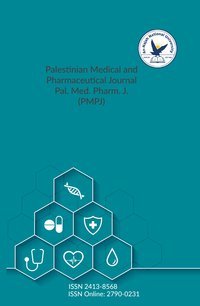Assessment of dietary consumption in a group of pregnant women at their second and third trimesters in Amman
Article info
2021-09-19
2022-05-25
17 - 40
Keywords
- pregnancy
- Micronutrients
- The Second Half Of Pregnancy
- Macronutri-ents
- Public Health Issues
- Maternal Nutrition
- Nutrients Intake
- Malnutrition
- RDA
Abstract
Background: For a child's healthy growth and development, nutrition is indispensable before and during pregnancy. Meeting nutritional needs during pregnancy has always been a significant public health issue. Objective: The study aimed to assess and evaluate energy, macronutrients, and micronutrient consumption from food among pregnant women in Am-man Governorate during the second or third trimesters, then compare the consumption to the Recommended Dietary Allowance (RDA). In addition, it aimed to assess micronutrient con-sumption from foods and supplements; finally, it investigated macronutrient consumption among under-weight, normal-weight, overweight, and obese pregnant women. Methods: A cross-sectional study was carried out in 2018 at the Ministry of Health's (MoH) Maternal and Children Health Centers (MCHC) in Amman to assess the dietary intake in a convenient sample of 300 seemingly healthy pregnant women between 17 and 40 years old and at ≥ 13 weeks of gestation. Maternal demographic characteristics, medical history, anthropometric measurements, and dietary data (three-day recall) were collected. Results: The daily mean intake of carbohydrates exceeded the recommended intake in 45.3% of pregnant women. Fiber intake was less than 28g/day in 90% of them. Total fats intake (45.6g/day) was lower than the RDA in 42.3% of pregnant women. Two-thirds of the pregnant women consumed a moderate amount of saturated fats (14.6g/day). The mean daily intake of proteins was 50.5±20.2g—more than two-thirds consumed protein less than the RDA. Subsequently, intakes of all essential amino acids were below RDAs.The intake of fat-soluble vitamins was lower than RDA for vitamins D, E, and K.While, whereas vitamin A was higher than RDA. Copper and salt intakes were more significant than the RDA for minerals (calcium, fluoride, iodine, iron, zinc, and selenium). Conclusion: The results showed inadequate and imbalanced dietary intake compared to RDA. Maternal nutrition and diets of pregnant women in this study show alarming indicators that may negatively affect the well-being of both pregnant women and fetal growth.
Assessment of dietary consumption in a group of pregnant women at their second and third trimesters in Amman
المؤلفون:
معلومات المقال
2021-09-19
2022-05-25
17 - 40
الكلمات الإفتتاحية
- pregnancy
- Micronutrients
- The Second Half Of Pregnancy
- Macronutri-ents
- Public Health Issues
- Maternal Nutrition
- Nutrients Intake
- Malnutrition
- RDA
الملخص
Background: For a child's healthy growth and development, nutrition is indispensable before and during pregnancy. Meeting nutritional needs during pregnancy has always been a significant public health issue. Objective: The study aimed to assess and evaluate energy, macronutrients, and micronutrient consumption from food among pregnant women in Am-man Governorate during the second or third trimesters, then compare the consumption to the Recommended Dietary Allowance (RDA). In addition, it aimed to assess micronutrient con-sumption from foods and supplements; finally, it investigated macronutrient consumption among under-weight, normal-weight, overweight, and obese pregnant women. Methods: A cross-sectional study was carried out in 2018 at the Ministry of Health's (MoH) Maternal and Children Health Centers (MCHC) in Amman to assess the dietary intake in a convenient sample of 300 seemingly healthy pregnant women between 17 and 40 years old and at ≥ 13 weeks of gestation. Maternal demographic characteristics, medical history, anthropometric measurements, and dietary data (three-day recall) were collected. Results: The daily mean intake of carbohydrates exceeded the recommended intake in 45.3% of pregnant women. Fiber intake was less than 28g/day in 90% of them. Total fats intake (45.6g/day) was lower than the RDA in 42.3% of pregnant women. Two-thirds of the pregnant women consumed a moderate amount of saturated fats (14.6g/day). The mean daily intake of proteins was 50.5±20.2g—more than two-thirds consumed protein less than the RDA. Subsequently, intakes of all essential amino acids were below RDAs.The intake of fat-soluble vitamins was lower than RDA for vitamins D, E, and K.While, whereas vitamin A was higher than RDA. Copper and salt intakes were more significant than the RDA for minerals (calcium, fluoride, iodine, iron, zinc, and selenium). Conclusion: The results showed inadequate and imbalanced dietary intake compared to RDA. Maternal nutrition and diets of pregnant women in this study show alarming indicators that may negatively affect the well-being of both pregnant women and fetal growth.
An-Najah National University
Nablus, Palestine
Nablus, Palestine
- P.O. Box
- 7, 707
- Fax
- (970)(9)2345982
- Tel.
- (970)(9)2345560
- (970)(9)2345113/5/6/7-Ext. 2628
- [email protected]
- EIC
- Prof. Ismail Warad
